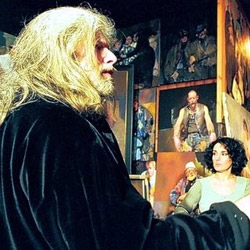 Found, a page torn from a copy of the Bookdealer dated 13th November 2003 previewing the forthcoming sale at Sotheby’s of the collection formed by the artist and book collector Robert Lenkiewicz.
Found, a page torn from a copy of the Bookdealer dated 13th November 2003 previewing the forthcoming sale at Sotheby’s of the collection formed by the artist and book collector Robert Lenkiewicz.
Because of his reclusiveness, little was known about Lenkiewicz before he died in 2002 aged just 60. A media frenzy then broke out. There are so few genuine eccentrics in the art world that the press can hardly afford to ignore such a prime example as Lenkiewicz. Here is a passage from the preview:
‘Here we have a man who faked his own death some years before he died …and lived for a few days in hiding at the Cornish home of one of his patrons, the Earl of St Germans. He was notorious for befriending and patronising vagrants and tramps, in particular one Edwin McKenzie, who lived in a concrete tube on a rubbish dump and preferred to be known as Diogenes. Since Diogenes’ death in the 1980s the whereabouts of his bodily bits were a mystery, until his embalmed remains were discovered in a secret drawer in a bookcase at Lenkiewicz’s Barbican library. ‘
‘If you remain unimpressed there were other discoveries including what was left of the condemned 16th –century witch, Ursula Kemp. Her skeletal remains, which had been nailed to the coffin, are believed to have been disinterred in Victorian times. This find nicely compliments his great book collection, illustrating as it does Lenkiewicz’s obsessive curiosity with life and death’.
The Barbican, it must be noted, is a quarter of Plymouth, England, in which the artist had settled, not the huge residential complex in the city of London. Included in the sale, which was mainly devoted to the occult, witchcraft, and demonology, was a rare first of Malleus Maleficarum (Hammer of the Witch ) published in 1487 by Dominican scaremonger and bigot , Heinrich Kramer, which had 16th century annotations in German. This was secured by a UK buyer for an eye watering £78,000–four times its lowest estimate. Another gem, Saducismus Triumphatus, a later seventeenth century pocket guide to the identification if witches by latter day ‘ witchfinder-general ‘ Joseph Glanvill, also did well . Among these classic books on witchcraft and demonology were other memorable seventeenth century works, including Hobbes’ Leviathan and studies by Leibniz and John Locke, unquestionably England’s greatest philosopher.
The sale saddened many of Lenkiewicz’s friends and admirers, who posted their opinions on the artist’s official website. Lenkiewicz had wanted his library to be kept together as a resource for the use of students interested in the occult. However, as he had died leaving debts of around £2m, the auction was inevitable. In the end the sale fetched £596,000—just over the upper estimate. [R.M.Healey]

Lenkiewicz’s real accomplishment was acquiring debts of £2 million. What was his secret? Most of us get drastically dealt with long before we reach that sort of amount!
Thanks Roger. One kind of success is getting yourself into very large debt (or being allowed and taking a big overdraft) Perhaps he bemused his bank manager with his art. Certainly it has made good sums since he died, and he was prolific..